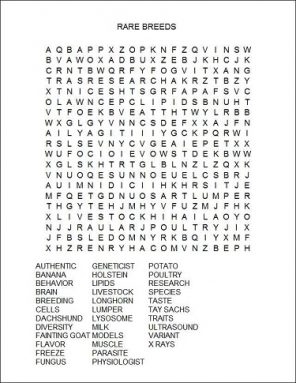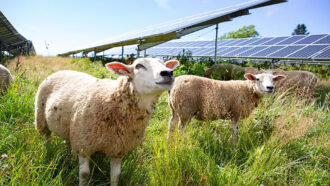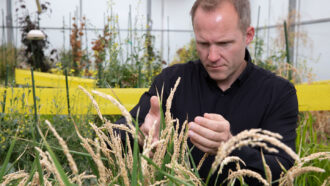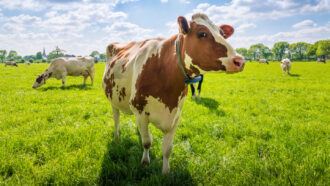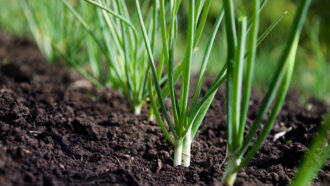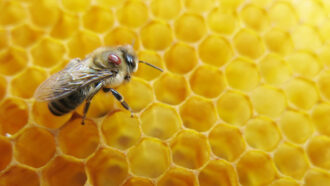Livestock: A need to save rare breeds
Rare livestock breeds possess special traits that can help farmers (and diners) now — and in the future
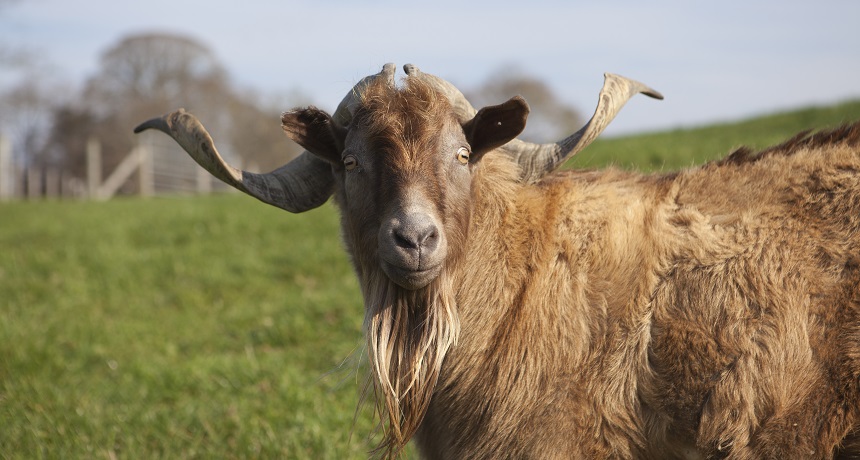
Chip and other Tennessee fainting goats fall over when startled. That’s because their muscles all stiffen up. Such rare breeds also may hold far more useful traits — ones that breeders find worth saving.
SVF Foundation
Make sure the ground is soft before startling Chip. He’s a Tennessee fainting goat at a farm in Newport, R.I. When Chip or other fainting goats get surprised, their muscles freeze up. Then “they just fall over — stiff like a board,” says George Saperstein. He’s a veterinary professor at Tufts University in North Grafton, Mass., and an adviser to SVF. It’s the foundation that runs the farm on which Chip lives.
Falling over won’t hurt Chip. Within a few seconds, a fainting goat will get up again. Numbers of this breed are up too. And that’s good news, because Chip’s breed is quite rare.
Fewer than 10,000 Tennessee fainting goats remained a few years ago. Now the breed is recovering. But its numbers still aren’t high, reports the Livestock Conservancy. So this group, based in Pittsboro, N.C., is keeping a close eye on the breed. Like SVF, the Livestock Conservancy is working to keep rare breeds of farm animals from going the way of the dodo: extinct.
A breed is a type of domesticated animal with uniform traits. Dachshunds, labs and poodles, for example, are different breeds, but they all belong to the same species — the domestic dog. There are different breeds of livestock — farm animals — as well. More than two dozen breeds of pigs exist, for instance. All can mate with others of their species (Sus scrofa) and produce healthy offspring.
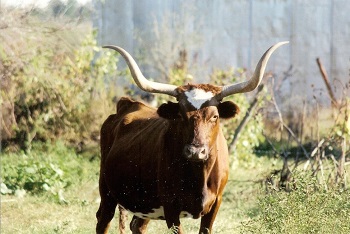
Animal breeds on the Livestock Conservancy’s “critical list” have worldwide populations of fewer than 2,000 individuals. Poultry can go on the list too if there are fewer than 1,000 of their breed of fowl on the planet.
As numbers of a livestock breed fall, the breed risks becoming extinct. This has happened in the past: Six of the 15 breeds of pigs that lived in the United States in the 1930s are gone. Forever. Among the small black Choctaw hogs, fewer than 100 remain, says the Livestock Conservancy. They could be the next breed of pig to disappear.
Rare breeds often are not that popular among farmers, who tend to prefer animals that grow quickly and don’t take too much money to feed. “However, it’s important to keep the other breeds around,” stresses Julie Long. She’s a physiologist with the U.S. Agricultural Research Service in Beltsville, Md.
Indeed, today’s popular breeds may not fare as well in the future. But if a rare breed goes extinct, any special traits it possesses will disappear forever too. Those traits might help an animal resist disease or thrive in harsh conditions, for example.
Fortunately, work is underway to save today’s rare breeds.
Too well bred?
For thousands of years, farmers have guided animals’ reproduction. Humans chose which cow or goat, for example, would mate with another. In this way, farmers could guide the development of desirable traits, such as flavor, size, color, behavior or resistance to disease. Those traits come from particular versions of certain genes, called gene variants. Different gene variants might lead to white, brown, black or red hair, for example.
“Because we are trying to feed an ever-growing population, we are really homing in on very specific production traits for most of our animals,” says Long. For example, black-and-white Holstein cattle produce lots of milk. Black Angus cattle provide flavorful beef.
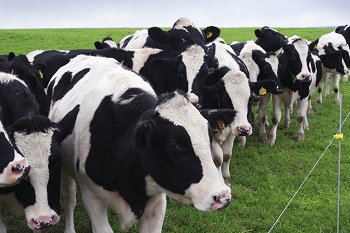
Paul Revere, the famous American Revolutionary War patriot, likely rode a Narragansett pacer horse. “Now it’s gone,” says Phillip Sponenberg. He’s an animal geneticist at the Virginia-Maryland Regional College of Veterinary Medicine in Blacksburg, Va. The Conestoga horse also is gone. This breed pulled those heavy wagons that settlers used when they migrated West in the 1800s.
“These breeds are a reflection of the people and their cultures,” says Sponenberg. “They tell us who we were and where we came from.”
Today, global populations of some livestock breeds consist of only a few hundred or thousand animals. Take the Choctaw hogs. Fewer than 100 remain. But these animals easily feed themselves on Oklahoma’s open range. Yet weighing only about 54 kilograms (120 pounds), they produce little meat. That’s why few farmers raise them anymore. Yet their meat is very tasty. And the pigs survive well in the region’s high heat and low-quality rangeland. That’s why some farmers think efforts should be made to keep this breed around.
Food security for the future
As populations of rare breeds dwindle, so does the genetic diversity of their species. Genetic diversity refers to the degree of variation among different versions of genes. Some genes help a species resist a disease. As genetic diversity drops, those protective genes may die off with the disappearing animals. And that could put food security at risk. One epidemic might wipe out nearly all of them at once.
“That has not occurred on a widespread scale with animal livestock,” says Long at the government’s Beltsville research center. Still, she notes, “it’s something we have to be ever vigilant about.”
And with good reason. A lack of genetic diversity already has caused problems in some plants, she notes. Plant breeds are known as varieties.
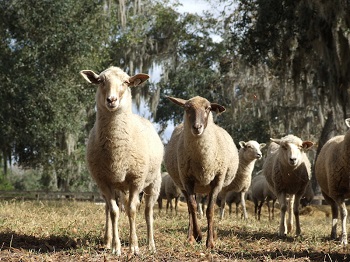
And potatoes are hardly an unusual example. All of today’s sweet bananas in grocery stores, for example, belong to a variety called the Cavendish. These bananas are clones — genetic twins of each other. And that means they all are vulnerable to a disease now spreading across the globe.
Keeping lots of different varieties or breeds around ensures that a species has lots of genetic diversity. That diversity can be useful. Even traits that don’t seem important today could help feed people in the future. History provides an example.
During the 18th century, Europe’s population grew. So did its need for food, such as pork. The problem intensitifed as more people began living in cities. However, European pigs didn’t produce large litters. They had lost a gene variant that would let a pig give birth to lots of young. Fortunately, Asian pigs still hosted that gene variant. So Europeans imported Asian pigs and cross-bred them with European pigs. The descendants of those animals again produced lots of piglets.
“We don’t know why this variant was originally lost in Europe,” says Mirte Bosse. She studies pig genetics at the Animal Breeding and Genomics Centre at Wageningen University in the Netherlands. Bosse and other scientists recently studied the genetic traits involved in the historic European cross-breeding of these pigs. Nature Communications published the findings in July 2014.
Without rare breeds, farmers might not be able to do that kind of cross-breeding in the future. And that could become increasingly important as the world continues to change.
“We don’t want to lose any of the diversity in our livestock in a time of climate change and social change and so on,” says livestock geneticist Alison Martin. It is foolhardy, she argues: “You don’t want to throw away anything that can’t be replaced.” Martin directs research programs at the Livestock Conservancy.
For example, a Holstein’s milk production drops when it gets too hot. But Florida cracker cattle handle heat and humidity well. They resist parasites too. (Parasites are bugs, worms or other organisms that live off another species at their host’s expense.)
Fewer than 1,300 Florida cracker cattle remain, though. These bovines weigh about half as much as Holstein cows, and they don’t produce much meat or milk. But these cows — or at least their genes — could prove useful as the climate heats up, owing to global warming. Farmers might be able to mate them with other breeds. The cows’ offspring might then better tolerate the heat while still producing lots of milk.
Florida Cracker sheep also have these traits. They weigh less than more common breeds, however. And that has made them less popular and helps explain why fewer than 300 still exist.
Solving mysteries
Even “bad” gene variants sometimes can prove valuable — at least to science. Several years ago, Jacob lambs on one Texas farm kept dying. They had Tay-Sachs disease. This rare genetic disorder affects the brain and spinal cord.
Human infants born with two copies of the variant Tay-Sachs gene rarely survive to their sixth birthday. The disease comes from a problem affecting the kids’ lysosomes. Lysosomes are “like a trash can in the cell,” explains Paola Torres. She’s a biochemist at New York University’s Langone Medical Center in New York City. Due to the lysosome problem, cells can’t break down a certain lipid (a type of fat).
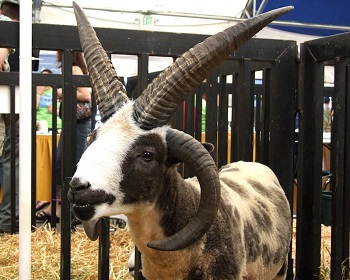
Previously, scientists had no good animal model for studying Tay-Sachs. That made it difficult to study or test possible treatments for humans. Animal models give scientists a window into how parts of the human body likely work — and what diseases do. They also let researchers test treatments before trying them out on people.
“Therapies for children with Tay-Sachs disease now can be tested in an authentic animal model,” says Douglas Martin. He’s a biomedical researcher at Auburn University in Alabama. By “authentic,” he means these sheep have the same defect as humans and develop the same symptoms.
This animal model has other benefits, too. The brain size in a lamb is about one-fifth the size of a human infant’s brain. “You can really study the brain at the same level [or scale] that you would probably do with a child,” explains Torres. And sheep are fairly easy to raise in labs.
By working with the lambs, Martin has found a promising line of treatment. “Treated sheep can live to about 15 to 16 months of age, while untreated sheep live to nine months,” he says. Big challenges remain, but this research could lead to life-extending treatments for children with Tay-Sachs.
Help for farmers
Throughout the world, small groups of people are now working to help preserve many rare breeds of farm animals. One goal is to increase the number of desirable traits in those breeds. “We do a lot of educational workshops to teach people those skills” that master breeders of the past had used to improve poultry and livestock, explains Martin at the Livestock Conservancy.
For instance, one project has focused on ways to develop Buckeye chickens that produce more eggs or more meat. Each would increase a farmer’s profits.
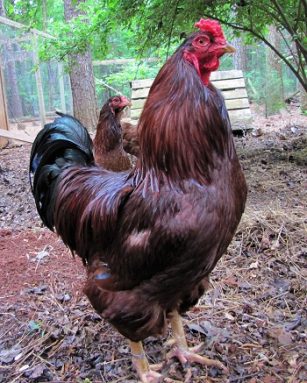
Computer programs also can help. They can warn if members of a rare breed are becoming too closely related. This is a condition known as inbreeding. When it occurs, the whole breed can suffer. Inbred animals “become weak and don’t reproduce very well,” explains Sponenberg.
Other work aims to increase sales of meats and cheese from rare breeds. Those products typically cost more than do those from common breeds that grow faster or produce more per pound of feed. But some people will pay extra if a breed offers something special. They might like a breed’s living conditions or prefer the taste of its meat.
However, Saperstein says, “People aren’t going to pay extra unless it truly tastes better.” Also, many restaurants and food distributors believe they need meat quality and size of cuts to be uniform for their customers. The meat and other products from rare breeds aren’t always the same, though. People who work with rare breeds hope to change the current view that consistency is best.
No work can recover breeds that have already been lost. But with the help of science, researchers can insure a future for today’s rare breeds.
Power Words
animal model A nonhuman animal used to stand in for people in research testing. Which animal a lab uses will depend on how closely parts of its body or chemical-signaling systems match those in people.
artificial insemination Process for putting semen (male reproductive cells) into an female animal to get her pregnant. The practice makes it possible for the animals to reproduce sexually without having to be present in the same place at the same time.
behavior The way a person or other organism acts towards others, or conducts itself.
biochemistry The study of chemical processes and chemical transformations that take place inside organisms. A scientist working in this field is known as a biochemist.
breed (noun) Animals within the same species that are so genetically similar that they produce reliable and characteristic traits. German shepherds and dachshunds, for instance, are examples of dog breeds. (verb) To produce offspring through reproduction.
climate change Long-term, significant change in the climate of Earth. It can happen naturally or in response to human activities, including the burning of fossil fuels and clearing of forests.
clone An organism that has exactly the same genes as another, like identical twins. Often a clone, particularly among plants, has been created using the cell of an existing organism.
cross-breeding Breeding two organisms that each host different traits (such as body size or milk production in animals) in hopes of getting offspring with the desirable traits of each parent. (in botany) Taking pollen from one plant variety and using it to pollinate flowers of another variety. Such plants tend to exhibit features of both parent plants.
domesticated animal A tame animal that commonly lives with people, such as a dog, cat or horse.
extinct An adjective that describes a species for which there are no living members.
fat A natural oily or greasy substance occurring in animal bodies, especially when deposited as a layer under the skin or around certain organs. Fat’s primary role is as an energy reserve. Fat is also a vital nutrient, though it can be harmful to one’s health if over consumed in excess amounts.
fungus (plural: fungi) One of a group of single- or multiple-celled organisms that reproduce via spores and feed on living or decaying organic matter. Examples include mold, yeasts and mushrooms.
gene (adj. genetic) A segment of DNA that codes, or holds instructions, for producing a protein. Offspring inherit genes from their parents. Genes influence how an organism looks and behaves.
genetic Having to do with chromosomes, DNA and the genes contained within DNA. The field of science dealing with these biological instructions is known as genetics. People who work in this field are geneticists.
genetic diversity The range of genes types — and traits — within a population.
global warming The gradual increase in the overall temperature of Earth’s atmosphere due to the greenhouse effect. This effect is caused by increased levels of carbon dioxide, chlorofluorocarbons and other gases in the air, many of them released by human activity.
inbreeding The mating of animals that are too closely related, genetically. It is the opposite of genetic diversity. Animals that are inbred tend to become weak or sickly and often cannot reproduce successfully.
Industrial Revolution A period of time in the early 1800s marked by new manufacturing processes and a switch from wood to coal and other fossil fuels as a main source of energy.
lipid A type of fat.
livestock Animals raised for meat or dairy products, including cattle, sheep, goats, pigs, chickens and geese.
nervous system The network of nerve cells and fibers that transmits signals between parts of the body.
parasite An organism that gets benefits from another species, called a host, but doesn’t provide it any benefits. Classic examples of parasites include ticks, fleas and tapeworms.
species A group of similar organisms capable of producing offspring that can survive and reproduce.
Tay-Sachs disease A fatal disease affecting the nervous system. It is caused by inheriting two rare forms of a gene, one from each parent,that render patients’ cells incapable of breaking down a particular lipid.
technology The application of scientific knowledge for practical purposes, especially in industry — or the devices, processes and systems that result from those efforts.
trait In genetics, a quality or characteristic that can be inherited.
ultrasound Sounds at frequencies above the range that can be detected by the human ear. (adj. ultrasonic)
variant (in biology) Members of a species that possess some feature (size, coloration or lifespan, for example) that make them distinct. (in genetics) A gene having a slight mutation that may have left its host species somewhat better adapted for its environment.
variety (in agriculture) The term that plant scientists give to a distinct breed (subspecies) of plant.
X-ray A type of radiation analogous to gamma rays, but of somewhat lower energy.
Word Find (click here to enlarge for printing)
